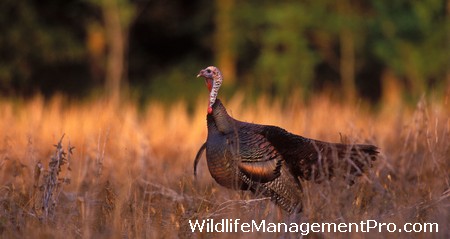Turkeys need suitable habitat to survive and thrive. Turkey management is primarily about habitat; maintaining, developing and managing suitable food, cover and water. The best turkey cover is a well-protected area of several hundred acres, preferably 500 acre or more. The majority, 60 to 90 percent, of the area can be forested/brushed, with a variety of tree species present. About 50 percent should be comprised of mature oaks, with an open understory. At least 10 to 15 percent of the area should consist of scattered, grassy openings at least one acre in size. Although the above describes ideal turkey habitat, habitat management is the key for healthy turkey populations.
The National Wild Turkey Federation (NWTF) will be accepting grant proposals through November 1, 2012 for funding projects on TPWD’s WMAs, other public lands, cooperative habitat projects on Wildlife Cooperatives and Wildlife Management Associations, prescribed burn associations, youth outdoor education events, and upland game bird research projects. NWTF has a very simple application process and they are no longer focused solely on wild turkeys. Any project with a focus on upland game birds and habitat management qualify. Proposals will be reviewed/ranked at the January 2013 Texas State NWTF Board meeting and funds will be allocated soon after.

Persons interested in funding for a turkey habitat management project should read the Super Fund Proposal Form and Instructions. Contact the NWTF if you have any questions. If you are interested in applying they can also provide copies of recently funded proposals. Please feel free to share this article with who may have qualifying habitat and management projects. Project proposals should be returned to Gene Miller at gmiller@nwtf.net.
Fire for Turkey Management
“Fire is among the most valuable and cost-effective tools available for managing turkey habitat yet is probably the least understood. A prescribed burn removes vegetation from only part of the total area. Additionally, the recovery of burned areas is swift and the resulting new vegetation and conditions on the ground are almost ideal for wildlife. The benefits prescribed fire include: reducing plant litter, the accumulation of which makes walking and food foraging difficult for poults; controls woody plants; releases dormant seeds; and increases the number of small insects attracted to the new vegetation.
Burning in late winter or early spring removes litter and grass thatch and encourages forbs such as butterfly pea, lespedezas, milkpeas, partridge peas and beggarlice. Burn a parcel once every two to five years. Areas left alone will advance into less desirable stages of succession and will produce unfavorable habitat for wildlife. Burning benefits not only turkey, but other game animals such as quail and white-tailed deer. Land users should either undergo training or become certified in the use of prescribed fire, or retain a professional who has training and experience in prescribed burning. It is essential to have the proper equipment and permits to plan and conduct a controlled fire.”